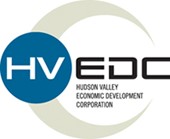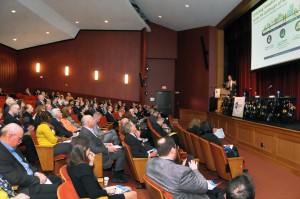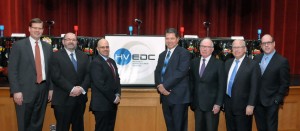Business executives, community leaders learn about digital innovation strategies and the need for technology utilization
 POUGHKEEPSIE, N.Y. (March 25, 2016) – Exploring the spectacular growth of higher education and health care as regional “anchor institutions” with a panel of area health care CEOs and college deans, the Hudson Valley Economic Development Corp’s (HVEDC) Hudson Valley EDs & MEDs Power Panel, the latest Thought Leaders Master Series program, addressed the need for utilizing new technologies and innovative strategies in these two important industry sectors.
POUGHKEEPSIE, N.Y. (March 25, 2016) – Exploring the spectacular growth of higher education and health care as regional “anchor institutions” with a panel of area health care CEOs and college deans, the Hudson Valley Economic Development Corp’s (HVEDC) Hudson Valley EDs & MEDs Power Panel, the latest Thought Leaders Master Series program, addressed the need for utilizing new technologies and innovative strategies in these two important industry sectors.
More than 250 registered for the event, where business executives and community leaders gathered at the Nelly Goletti Theatre at Marist College to hear examples of organizational success and forecasts about future health care and education trends.
“If you look at labor data from the past several years, it is quite clear that health care and higher education are major economic engines and significant job generators,” said Laurence P. Gottlieb, HVEDC president and CEO. “Given their important role in a thriving Hudson Valley economy, with over a billion dollars in expansion plans announced just within the past year, we felt it was important to hear directly from their top executives how we as a community can support their ambitious plans for growth.”
Chad Rynbrandt, head of strategy and business development for global health care technology leader, Philips NA, was the keynote speaker. Rynbrandt’s presentation, “Digital Innovation in Health Care,” applied supporting data from other major industries to explain the critical need for digital talent to fuel future health care and education innovation. The Westchester Medical Center Health Network recently signed a $500 million, 15-year agreement with Philips, as the company will supply state-of-the-art technology and strategic consultation in service to millions of Westchester Medical Center Health Network customers throughout the region.
Health care costs were $3 trillion, or 18 percent of the nation’s gross national product, in 2015. It’s a huge industry requiring new and innovative ways of providing care, he said.
“Digital innovation allows us to make the connections we need to better inform an engaged public,” said Rynbrandt. “That also allows us to get diagnoses right the first-time. There will also be minimally invasive therapies.”
As examples, Rynbrandt spoke about how Google sensors embedded into contact lenses can monitor blood glucose levels. Google, he said, has also created digital technology that tells eye glass wearers who they are looking at through facial recognition technology, which can be of great benefit to Alzheimer’s patients. He also spoke about how sensor transmitters from Redwood City, Calif.-based Proteus are now embedded into medication and activated by stomach acid, generating signals picked up by a disposable bandage-like patch on patient torsos to keep tabs on chronic illness statuses and overall medical needs.
Rynbrandt also spoke about Westchester Medical Center Health Network’s innovative use of “eHealth telehealth” technology, an initiative to improve patient outcomes throughout the Hudson Valley. With multimedia stations equipped with the latest telehealth patient monitoring technologies and software, this hub is staffed around the clock by highly trained physicians, nurses and other health care professionals. They serve, remotely, as a complement to the dedicated care teams for patients in network hospitals, nursing homes, physician offices and, eventually, homes across the region.
“This is a wonderful example of how digital innovation, practically applied, makes a difference in people’s lives,” he added.
Rynbrandt felt the implications to medical providers and suppliers included the need to manage talent as a strategic asset; apply outside thinking to challenge the status quo; use different hiring sources and have new roles in health systems, including: pop health, analytics, digital innovation, clinical transformation, customer experience and care coordinators.
Implications for the education industry include fluency in digital approaches and business models; creating a positive patient/consumer experience; partnering with suppliers and health care providers; and inspiring students.
A panel of regional, senior-level and higher education and health care executives followed in a thought-provoking discussion, featuring: Scott Batulis, president and CEO of the Greater Hudson Valley Health System; Joseph DiCarlo, senior vice president and director of human resources of WESTMED Practice Partners; James DuMond, Ph.D., dean of the School of Science at Marist College; Paul Hochenberg, executive director of MidHudson Regional Hospital, member of the Westchester Medical Center Health Network; and Luke McGuinness, Health Quest CEO.
Hochenberg spoke about how technology advancements raise the standard in patient care, noting the majority of MidHudson’s capital costs are tied to technology acquisitions.
McGuinness equally addressed the impact of technology and how it positively affects an organization’s physical plant as well as human resource development. “What I tell people is that I’m in the people business, but we also happen to deliver health care.”
Like others, Batulis called his organization a transformational one. “We have the first replacement hospital in 20 years in New York State,” he said. “We’re working smarter and better to drive down costs.”
Orange Regional Medical Center’s relationships with area higher education institutions result in more than 800 students rotating through the hospital annually, Batulis added, with other panelists supporting these important connections.
DiCarlo spoke about changes in the workforce, noting efficiency and empathy are keys to success. The use of analytics, he said, was never heard of 10 years ago and is now a mandatory key to the best possible patient outcomes. He also noted health care consumers have so many choices and a positive patient experience is critical, requiring organizations like WESTMED to “reframe what the clinical professional looks like today.”
“People don’t come to us because they feel great,” Di Carlo said. “We focus on empathic, patient-centric care. We want an unbelievably positive experience. And we tell people, take computer science if you want to be employed.”
DuMond spoke about the importance of paying attention to the Hudson Valley landscape, adding the STEM (Science, Technology, Engineering and Math) field is being recognized by students as stepping stones for a “nice paycheck.” Additionally, he said, relationships with area community colleges and health care providers remain critically important, and are balanced with making sure technology used by those health care providers is the same used by Marist when training its students.
Like others, DuMond added that Marist makes every effort to use local sources when purchasing supplies, for construction projects or other procurement needs.
Collectively, the panelists’ further thoughts included the important need of maintaining good relationships with area colleges. They felt information technology needs will only continue grow and become more sophisticated, requiring everyone to be more technologically savvy than ever before. And they know that consolidation of hospitals has come late to New York State, with the decommissioning of acute care beds becoming an eventual reality.
Another takeaway was that only organizations that can accumulate capital will survive, with the biggest capital investment being technology. The panel also stressed that maintaining employee skills and efficiency equally remains at the forefront of the provision of care, with health care providers looking to education institutions to build and maintain proficiencies in staff.
Westchester Medical Center Network, Regeneron, Think Dutchess Alliance for Business, Orange Regional Medical Center, Touro College of Osteopathic Medicine, Health Quest, Alianza, WESTMED Medical Group, Marist College and Adelphi University served as the event’s sponsors.
Photo 1: Chad Rynbrandt, head of strategy and business development for global health care technology leader, Philips NA, addresses a crowd at Marist College as the keynote speaker.
Photo 2: Chad Rynbrandt, head of strategy and business development for global health care technology leader, Philips NA; James DuMond, Ph.D., dean of the School of Science at Marist College; Joseph DiCarlo, senior vice president and director of human resources of WESTMED Practice Partners; Scott Batulis, president and CEO of the Greater Hudson Valley Health System; Luke McGuinness, Health Quest CEO; Paul Hochenberg, executive director of MidHudson Regional Hospital, member of the Westchester Medical Center Health Network; and Laurence P. Gottlieb, HVEDC president and CEO.
About Hudson Valley Economic Development Corporation (HVEDC)
HVEDC is the leading economic development agency for the seven-county region of Westchester, Putnam, Dutchess, Rockland, Orange, Ulster and Sullivan counties. The public-private partnership markets the region as a prime business location to corporate executives, site selection consultants and real estate brokers. HVEDC helped start the organizational, branding and promotional effort for NY BioHud Valley, Hudson Valley 3D Printing, Hudson Valley EDs & MEDs and the Hudson Valley Food & Beverage Alliance. To learn more, call 845-220-2244 or visit http://www.hvedc.com.





